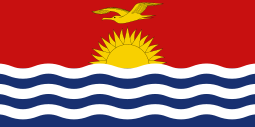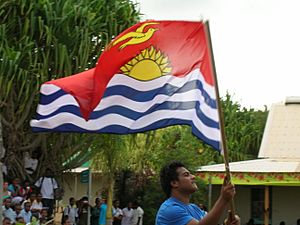Flag of Kiribati facts for kids
 |
|
| Use | National flag and ensign |
|---|---|
| Proportion | 1:2 |
| Adopted | July 12, 1979 |
| Design | A horizontal bicolour of red and blue with the yellow frigate bird flying over the rising sun with seventeen rays centered on the upper half and three white wavy horizontal stripes on the lower half. |
| Designed by | Arthur Grimble |
The flag of Kiribati is a special symbol for the country. It has a bright red top half with a golden frigatebird flying over a golden rising sun. The bottom half is blue with three wavy white stripes. These stripes look like ocean waves.
The flag tells a story about Kiribati. The blue and white waves show the huge Pacific Ocean that surrounds the islands. The golden sun reminds us that Kiribati is right on the Equator, where the sun is strong. The 17 rays coming from the sun stand for the 16 Gilbert Islands and Banaba island.
The golden frigatebird is a powerful symbol. It represents freedom, strength, and even the traditional dances of Kiribati. This flag design came from an older badge created by Sir Arthur Grimble in 1931.
Contents
What the Flag Means
The flag of Kiribati has important meanings for its people.
The Frigatebird
The bird on the flag is a frigatebird. It shows power and freedom. It also represents the special cultural dances of Kiribati.
The Rising Sun
The sun is shown rising because Kiribati is located right on the Equator. This means it gets a lot of sunshine!
The Ocean Waves
The blue and white wavy lines stand for the vast Pacific Ocean. This ocean surrounds all the islands of Kiribati. The three wavy stripes also represent the three main island groups: the Gilbert Islands, Phoenix Islands, and Line Islands.
How the Flag Was Created
The flag of Kiribati is based on an old design from when it was a British colony. This design was like a shield from a coat of arms.
Early Ideas for the Flag
In 1931, a man named Sir Arthur Grimble suggested ideas for the flag's design. He said:
- The sea shows how isolated the islands are in the ocean.
- The sun represents the islands' location near the 180-degree line of longitude.
- The frigatebird stands for power, balance, and freedom. For the local people, it was a sign of leadership.
Official Approval
The design for the coat of arms was officially approved in May 1937. It was then used on the flag of the Gilbert and Ellice Islands colony.
Choosing the New Flag
Before Kiribati became an independent country in 1979, there was a competition to choose a new national flag. A design based on the old colonial coat of arms was chosen.
However, some changes were suggested to this design. The frigatebird and sun were made bigger, and the wavy stripes were made narrower. But the people of Kiribati wanted the original design. They wanted the top and bottom halves of the flag to be equal. They also wanted the sun and bird to be smaller, with black outlines.
The new flag, with the people's preferred design, was raised for the first time on July 12, 1979. This was during the independence day celebrations in the capital city, Tarawa.
Historical Flags of Kiribati
-
Flag of the Gilbert and Ellice Islands (1937–1976)
-
Flag of the Gilbert Islands (1976–1979)
See also
 In Spanish: Bandera de Kiribati para niños
In Spanish: Bandera de Kiribati para niños








